Plants are photoautotrophs. What does this mean?
They use light energy to drive the synthesis of organic molecules from inorganic materials.
The ultimate source of energy to support most life on Earth is _____.
sunlight
Drag the labels from the left to their correct locations in the concept map on the right. Not all labels will be used.
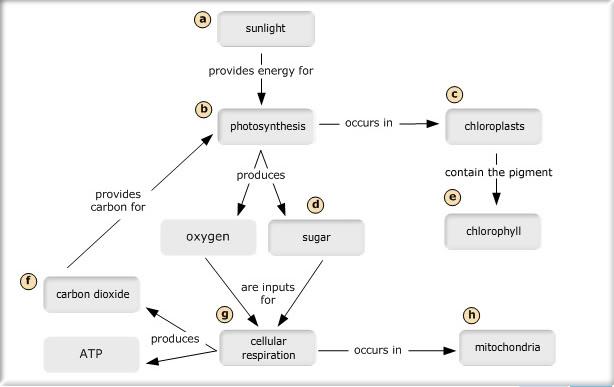
Which of these equations best summarizes photosynthesis?
6 CO2 + 6 H2O → C6H12O6 + 6 O2
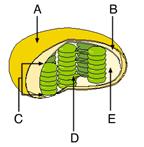
Where does the Calvin cycle occur?
E Stroma
The light reactions of photosynthesis use _____ and produce _____.
water ... NADPH NADPH is a reactant in the Calvin cycle.
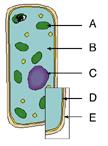
Identify the chloroplast.
A
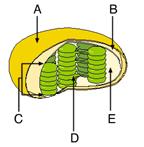
Identify the stroma.
E
Identify a thylakoid.
D
The photosynthetic membranes are found in the _____ in plant cells.
chloroplasts An elaborate system of interconnected thylakoid membranes segregates the stroma from the thylakoid space in the chloroplast.
When oxygen is released as a result of photosynthesis, it is a direct by-product of
splitting water molecules.
Approximately what wavelength of light is best absorbed by chlorophyll a, the pigment that participates directly in the light reactions?
435 nm
Which wavelength of light is best absorbed by chlorophyll b?
455 nm
You obtain the pigments called carotenoids in your diet when you eat carrots. Why do carotenoids appear yellow and orange?
They absorb blue/green light and reflect yellow and red wavelengths of light.
Can you tell from these absorption spectra whether red light is effective in driving photosynthesis?
One cannot tell from this graph, but because chlorophyll a does absorb red light, we can predict that it would be effective in driving photosynthesis.
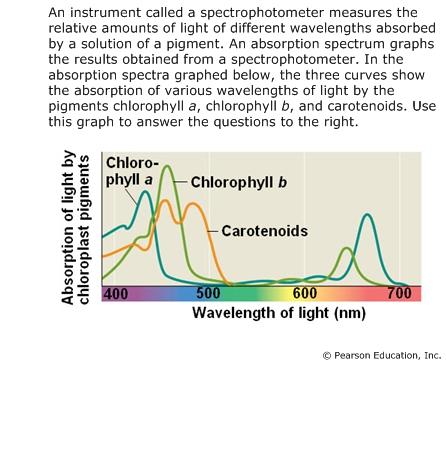
If only chlorophyll a were involved in the light reactions, would blue light (wavelength about 490 nm) be effective in driving photosynthesis?
The graph indicates that chlorophyll a absorbs very little blue light, so we can predict that blue light would not be effective.
An action spectrum plots the rate of photosynthesis at various wavelengths of visible light, and it shows that blue light with a wavelength of about 490 nm is effective in driving photosynthesis. Based on this information and the absorption spectra shown at left, what role may chlorophyll b and carotenoids play in photosynthesis?
These pigments are able to absorb more wavelengths of light (and thus more energy) than chlorophyll a alone can absorb. As part of light-harvesting complexes in photosystems, they broaden the range of light that can be used in the light reactions.
Which term describes ATP production resulting from the capture of light energy by chlorophyll?
Photophosphorylation The excitation of chlorophyll by light energy initiates a chain of events that leads to ATP production.
True or false? The chemiosmotic hypothesis states that the synthesis of ATP generates a proton gradient that leads to electron flow through an electron transport chain.
False
According to the chemiosmotic hypothesis, what provides the energy that directly drives ATP synthesis?
Proton gradient A proton gradient across chloroplast and mitochondrial membranes drives ATP synthesis by the enzyme ATP synthase.
Which of the following particles can pass through the ATP synthase channel?
Protons
True or false? The region of ATP synthase that catalyzes the production of ATP from ADP and inorganic phosphate spans the chloroplast membrane.
False
Chloroplast membrane vesicles are equilibrated in a simple solution of pH 5. The solution is then adjusted to pH 8. Which of the following conclusions can be drawn from these experimental conditions?
ATP will not be produced because there is no ADP and inorganic phosphate in the solution.
Which wavelengths of light drive the highest rates of photosynthesis? Select the two best answers.
400-450 nm 670-680 nm
input and output of light reactions
input: light, ADP, NADP+, water
output: O2, ATP, NADPH
Calvin cycle input and output:
Input: Co2, ATP, NADPH
Output:G3p, ADP, NADP+
In the light reactions, light energy is used to oxidize
H20 to O2
The Electrons derived from this oxidation reaction in the light reactions are used to reduce
NADP+ to NADPH
The Calvin cycle oxidizes the light reactions product
NADPH to NADP+
The electrons derived from this oxidation reaction in the calvin cycle are used to reduce
CO2 to G3p